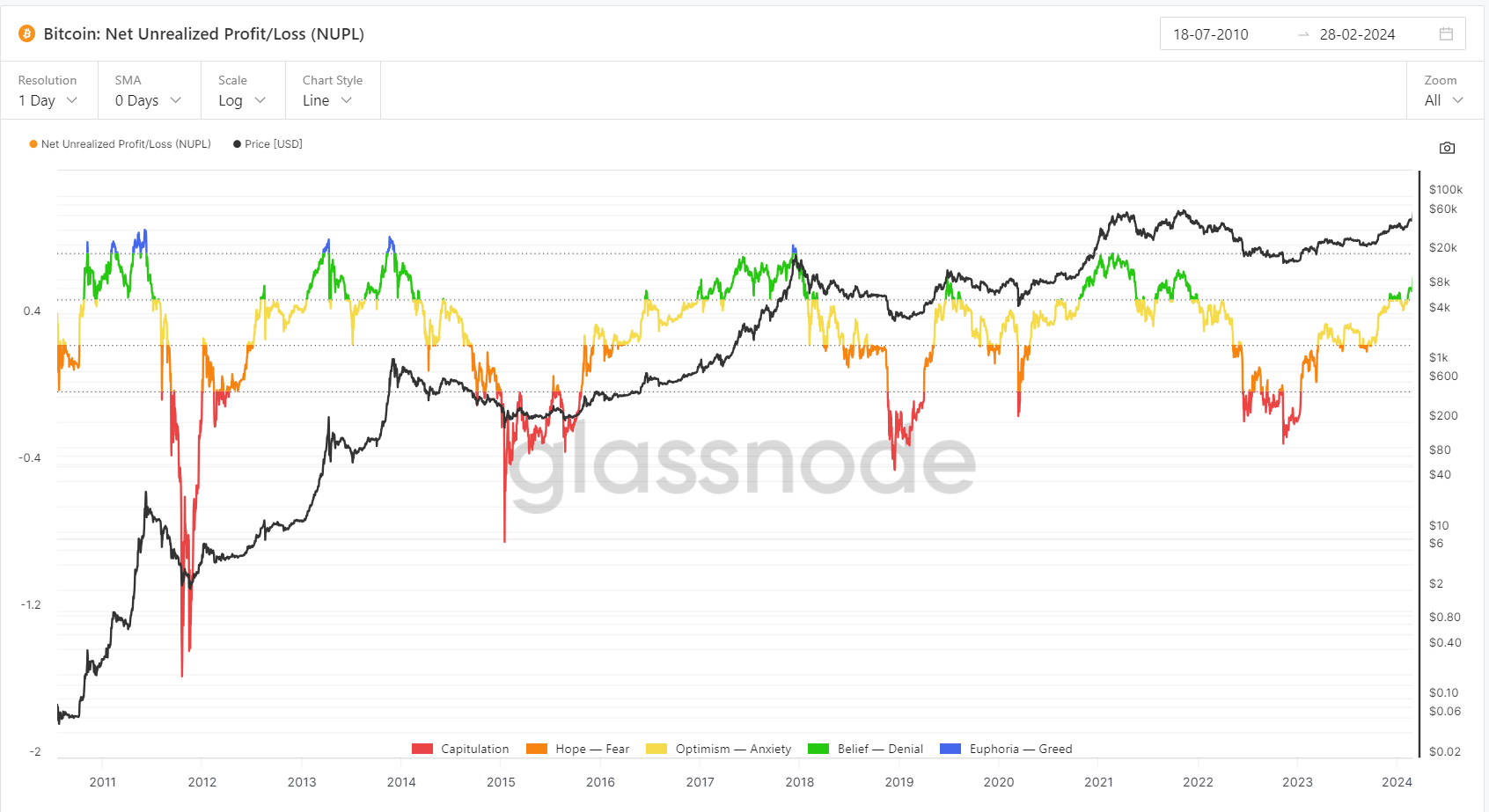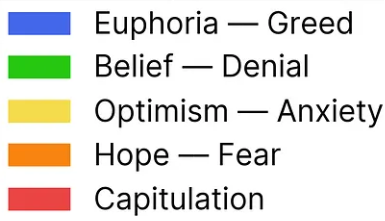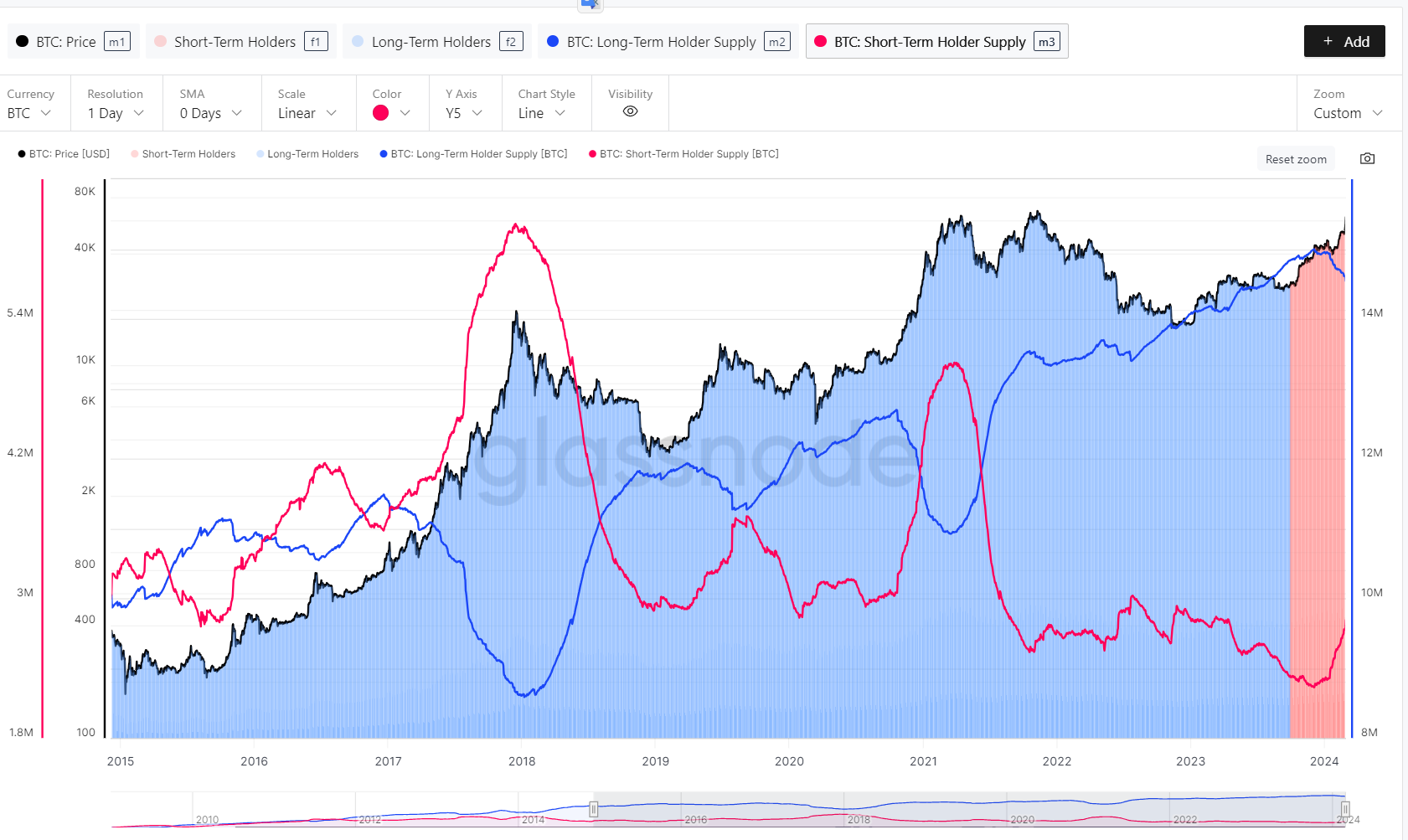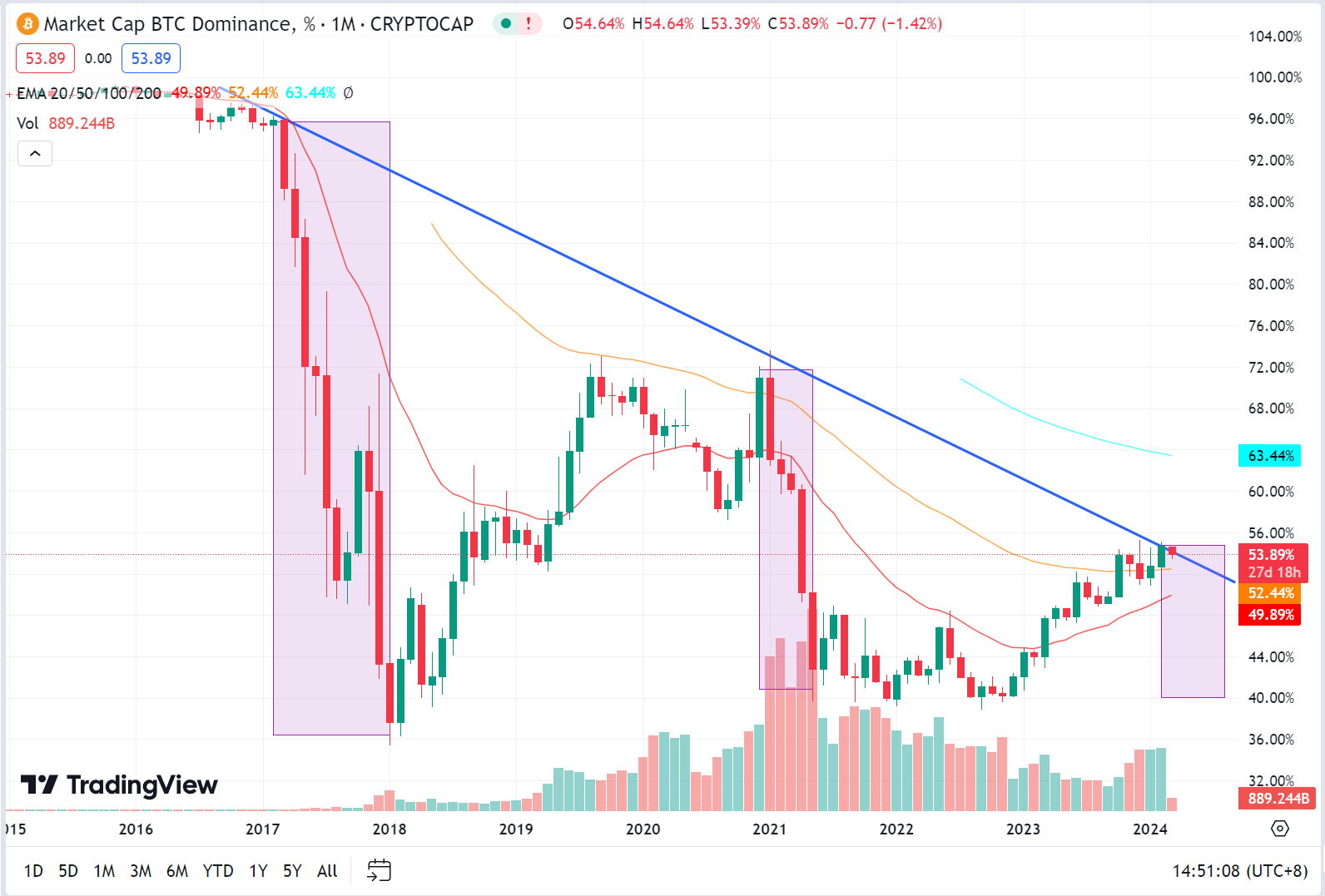LD Capital: Analyzing the market stage of BTC based on unrealized net gains and losses, changes in long and short positions, and the market capitalization ratio of BTC
Author: LD Capital, Duoduo
Last week, BTC broke through 64,000, coming very close to the previous bull market high of 69,000. At the same time, the prices of newly issued assets in the market are also being pushed higher, and a bubble is forming and amplifying. For players who accumulated BTC over the past two years, it's time to consider a question: What stage is BTC currently in? When should one take profits and exit?
Glassnode provides a wealth of BTC analysis indicators. Here, we select two indicators: Net Unrealized Profit/Loss (NUPL) and Long/Short-Term Holder Threshold to examine the current position of the market.
Net Unrealized Profit/Loss (NUPL)

The question that NUPL tries to answer is: At any given point in time, how much of the circulating supply of Bitcoin is in profit or loss, and to what extent?
NUPL describes the overall profit and loss status of BTC by calculating the difference between the current market cap and the realized cap. The formula for NUPL is: (Market Cap - Realised Cap) / Market Cap. The realized cap is the cumulative value of Bitcoin at the price when it last moved. The unrealized cap is obtained by subtracting the realized cap from the current market cap. If the unrealized cap is negative, the market is in an overall loss state; if positive, it indicates overall profit. Dividing the unrealized profit or loss by the current market cap gives the specific value of NUPL. The smaller the profit and the larger the loss, the closer it is to the bottom; the larger the profit and the smaller the loss, the closer it is to the top.
NUPL is divided into five zones: the red zone is below 0, indicating a loss area, which is also a buying zone. The orange zone is between 0 and 0.25, indicating a slight profit area. The yellow zone is from 0.25 to 0.5. The green zone is from 0.5 to 0.75. The blue zone is above 0.75. Generally, below 0.25 is considered a good buying area, while above 0.5 may indicate the onset of a bull market.

Looking at history, we can see:
- NUPL has effectively indicated the bottom area. The second half of 2022 was basically below 0. The indication for the top area is relatively broad. The bull market in 2017 briefly touched the blue zone, while in 2021, it did not touch the blue zone at all, operating entirely within the green zone. This increases the difficulty of judging the top area.
Currently, we are positioned in the green zone from early December to early January, then after nearly a month of decline into the yellow zone, we re-entered the green zone on February 7. This is the second time in this cycle that we have entered the green zone, lasting nearly a month.
- From December 2016 to January 2018, for a period of 14 months, NUPL was mostly in the green zone. During this period, BTC rose from $780 to $17,000, an increase of about 21 times.
From October 2020 to May 2021, and from August 2021 to December 2021, for a period of 11 months, NUPL was also in the green zone. During the period from October 2020 to May 2021, BTC rose from $13,000 to $63,000, an increase of about 4.8 times.
In terms of duration, the green zone has lasted for more than 10 months.
- It is important to note that the onset of the main waves of the previous two bull markets occurred after the halving. In comparison to this year, BTC was already close to a new high before the halving, and NUPL has been in the green zone for over 2 months. This time, it cannot be simply judged by the halving market.
In the previous two bull markets, the impact of halving on BTC supply was significant, leading to a substantial reduction in supply and increased mining costs, creating a supply-demand imbalance that promoted price increases. In this bull market, most BTC has already entered circulation, and the impact of halving on supply is reduced; at this time, the approval of BTC ETFs has brought in a large amount of buying, also creating a supply-demand imbalance, leading to an early market initiation. The BTC market will be more influenced by U.S. monetary policy and the U.S. stock market.
Long/Short-Term Holder Threshold

Long-term held BTC refers to BTC that has not moved from the same address for more than 155 days, while short-term held BTC refers to BTC that has been moved from the same address within 155 days. The changes in this indicator can show when long-term holders are accumulating tokens and when they are selling tokens.
Currently, the total amount of long-term held BTC is about 14.5 million, while the total amount of short-term held BTC is about 2.87 million, indicating that about 83% of BTC is in a long-term holding state.
Looking at history, we can see:
In early January 2017, when the BTC price reached $900, close to the bull market high of the end of 2013 ($1,000), long-term held BTC began to be sold off. This selling trend continued until early 2018. Correspondingly, the number of short-term held BTC increased significantly.
Throughout 2018, BTC was in a downward trend, while long-term held BTC was in an upward trend, with investors continuously accumulating BTC during this period.
In April 2019, after BTC broke through $5,000, long-term held BTC began to be sold off. By August 2019, after a decline, the number of long-term accumulated BTC rose again and continued until 2020.
In October 2020, after BTC broke through $11,000, long-term held BTC began to be sold off. This selling trend continued until April 2021.
In November 2021 and June 2022, long-term held BTC experienced brief declines, but thereafter showed a continuous growth trend.
In early December 2023, long-term held BTC began to be sold off. It decreased from a peak of 14.98 million to 14.5 million, a reduction of about 500,000. Currently, this trend is still ongoing.
BTC Market Cap Ratio (BTC.D)

Currently, BTC's market cap accounts for 53.87% of the total cryptocurrency market cap.
Looking at historical data, we can see:
BTC's market cap increases during bear markets and decreases during bull markets, with the lows of the bull markets in 2017 and 2021 both around 40%.
In each bear market, BTC's market cap ratio gradually decreases, forming a trend line. The current ratio is still within the trend line range. Since this bear market, the highest ratio has been around 54%.
At the peak of a bull market, BTC's market cap ratio should decline to around 40%. Currently, BTC's market cap ratio has not shown a clear downward trend.
Conclusion
When NUPL is above 0.5, BTC addresses have gained more than 50% unrealized profit. The range of BTC NUPL above 0.5 lasted for 14 months and 11 months during the bull markets of 2017 and 2021, respectively, and occurred after the halving. This year, it has already entered a generally profitable range for 2 months before the halving, and the market differs from previous ones, likely being more influenced by U.S. monetary policy and the U.S. stock market. For example, the determination of interest rate cuts may lead to market corrections.
From the perspective of Long/Short-Term Holder Threshold, the long-term held BTC is currently at a historical high. However, long-term holders have begun to gradually reduce their BTC holdings since December 2023. This behavior is similar to that in 2017 and 2020. Long-term holders will remain in a selling state between the previous bull market high and the current bull market high.
From the perspective of BTC Market Cap Ratio (BTC.D), BTC's market cap ratio is still at a high level and has not shown a significant downward trend; the altcoin rally has not yet started.
Overall, BTC is in the early stages of a main wave rally, while the altcoin main wave rally has not yet begun.









